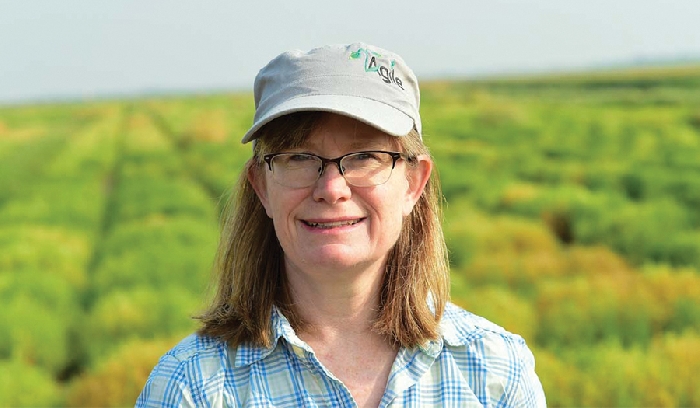USask researchers awarded funding to improve agriculture practices
January 26, 2021, 2:15 pm
Rob Paul, Local Journalism Initiative Reporter


Eighteen wide-ranging University of Saskatchewan (USask) crop research projects have been awarded a total of nearly $5.8 million through Saskatchewan’s Agriculture Development Fund (ADF), a program jointly supported by the federal and provincial governments and supplemented by industry partners.
Innovative research into disease resistant and nutritious crops, human health applications of cannabis, biodegradable plastics made of plants, and tracing the carbon footprint of an agricultural operation are among the USask projects supported by the program, which also attracted almost $1.9 million in total industry funding for the teams.
“This major investment in USask research is indicative of the key role the university plays in growing Saskatchewan’s capacity as a world leader in the agricultural sector,” said USask Vice-President Research Karen Chad. “The adoption of new agricultural technologies and creation of competitive, value-added products has the potential for real-life benefits, including new jobs and increased economic prosperity for the province.”
The ADF program is supported through the Canadian Agricultural Partnership, a five-year $388-million investment by the federal and provincial governments in strategic initiatives for the sector in Saskatchewan. A total of $9.8 million was announced January 12 for 39 agricultural research projects in the province and across the country, of which more than half were awarded to USask.
Major USask projects awarded funding include:
Strengthening pulse crops in the field and beyond: More than $1.4 million has been awarded from the ADF program to USask researcher Kirstin Bett for two projects:
Improving lentil quality and nutritional value by borrowing traits from wild lentils and developing new computerized imaging technology to target desirable seed characteristics. The results will lead to higher value lentils, and access to new, specialty markets for producers.
Developing high-yielding, disease-tolerant dry bean varieties. The results will provide new, high-value pulse crop options that are well-suited to irrigation.
Developing high-yielding chickpeas: Plant researcher Bunyamin Tar’an will use $730,000 from ADF to develop high-yielding, large seed kabuli chickpea varieties suited to Western Canada. The results will lead to new chickpea varieties, benefitting Saskatchewan’s producers and broader economy. Tar’an will also receive $236,000 from ADF to study how using genetic diversity from wild chickpeas could help combat Ascochyta blight, a major disease threatening chickpea production across Western Canada.
Breeding healthy peas for Western Canada: Tom Warkentin, Saskatchewan agriculture ministry’s Strategic Research Program Chair in Pulse Crop Breeding and Genetics, was awarded the largest single-study award from ADF this year—more than $981,000—to develop high-yielding, root-rot-resistant pea varieties. Root rot, a disease widespread across Western Canada caused by a combination of fungus and other pathogens, can destroy as much as 70 per cent of a farmer’s crop during a wet year.
Other innovative crop-related projects with potential economic impact include:
Finding plant-based climate-friendly alternatives to plastics ($360,000): Plant scientist Martin Reaney’s research aims to create carbon-neutral, biodegradable plastics from canola and pulse products to ease pressures on our oceans and landfills. Reaney is Saskatchewan agriculture ministry’s Strategic Research Program Chair in Lipid Quality and Utilization.
Measuring the carbon footprint of crops ($230,000): Plant scientist Kate Congreves’ research team will establish Saskatchewan’s first Greenhouse Gas Monitoring Station using micrometeorological techniques to measure greenhouse gases year-round and determine the net carbon footprint of a canola-cereal rotation. This type of field-scale data is needed to help the industry move forward in a carbon-based marketplace.
Solidifying cannabis as a Saskatchewan product ($188,000): Plant researcher Tim Sharbel will study the genetics of a cannabis seed material collection owned by Konetics, a company with ties to the Saskatchewan market. The goal is to strengthen the cannabis industry in the province through vigorous quality control of agronomic traits, in addition to connecting this material to the Cannabinoid Research Initiative of Saskatchewan for scientifically based studies on applications to human health.
Heading off disease in wheat ($410,000): In two projects, wheat breeder Curtis Pozniak will take aim at protecting wheat crops from fungal pathogens by identifying novel disease resistance in wheat strains from around the world, and by pinpointing the mechanisms used by Fusarium head blight—the most serious disease affecting wheat production in Canada—to overcome wheat’s defences.
Removing arsenic with agricultural waste ($70,000): Engineering researcher Jafar Soltan is testing the use of low-value agriculture residue—such as straw and meal from canola, barley, wheat, and mustard—to transform it into high-value adsorbents that remove arsenic from mining wastewater. Soltan and his team of experts will engage in research using the Canadian Light Source synchrotron and a pilot project that simultaneously works in two vital economic sectors: mining and agriculture.
The 18 USask projects attracted a total of almost $1.9 million from a wide range of organizations and agencies including Saskatchewan Pulse Growers ($634,000), Western Grains Research Foundation ($588,000), Saskatchewan Wheat Development Commission ($340,000), Saskatchewan Canola Development Commission ($186,000), Alberta Wheat Commission ($72,000), the Manitoba Crop Alliance ($66,000), and the Saskatchewan Oat Development Commission ($3,000).
Crop research to increase efficiency
Two of USask researcher Dr. Kristin Bett’s projects received over $1.4 million in funding through Saskatchewan’s Agriculture Development Fund (ADF) with both focused on examining crops and learning more about their traits to develop differing varieties.
“The big one is called EVOLVES (Value of Lentil Variation for Ecosystem Survival), it’s a lentil Genome Canada grant that we received just over a year ago and this is the provincial contribution to that larger $7.5 million project that we’re running. It’s a followup to a previous Genome Canada project we had that ADF also co-funded, and so the new one has got a genomic component, but what’s more interesting to the general public is that the genomic part of it all has to do with quality traits.
“The idea being that we need to stay ahead—there’s a whole issue in Kazakstan where they’re basically pilfering our genetics and then selling to our customers at a lower price because they’re closer. To get away from that, the idea of being in a position to stay ahead of them with quality genetics, but also start to look more at instead of bulk shipping focusing more on value added aspects. Can we develop the genetic know-how to very quickly and nimbly put together packages of genes in a variety that would give you the right size, shape, colour, B vitamin profile, protein content—there’s a whole range of different traits that we’re interested in look at the underlying genetics for.”
With the project studying lentils, Bett says they want to get a better understanding of the crop’s makeup so they’re able to know earlier how it will develop and what type of quality it will be, therefore making the process more efficient.
“The overall goal is to look at phenotyping and genotyping,” she said. Phenotyping is looking at different characteristics of a diverse set of lines. So we’re looking at that, but we also have the underlying genotypic information.
“We’re sequencing genomes so that we know all the genes that are in these and the idea is that we hope to take the phenotype and using fancy math you can put the two together and try to identify the region of the genome that contain genes that are controlling those traits. For instance, in lentils you can have yellow or red on the inside and that’s a single gene—we’ve known that forever—but can we figure out what is is that controls that genetically?
“It’s not super critical, but what it will do is then allow us to figure out how to get redder lentils because the pasta industry wants them to be super dark red, they don’t want the yellow/orange, they only want red. So can we figure out how to get really red lentils?
“Plant breeding is a long process, but if we can shorten the time frame to developing varieties that have the traits that the buyers are interested in—one way would be using molecular markers and the actual genotype rather just what it looks like to be a little bit quicker.
“We can screen material early on and get rid of the stuff that will be garbage. Basically our whole game is to throw away the bad stuff—the sooner you can throw away the bad stuff, the better because you’re not wasting any other resources on it and then you can focus your efforts on the ones that are good and then maybe you can segregate for other traits you don’t know about and then you can pick from amongst those. Efficiency is the whole goal—we want to increase the efficiency and effectiveness of the breeding program.”
The government funding was vital to moving the lentil project forward and Bett couldn’t be happier.
“If we hadn’t gotten this then not only would we have been out that amount of money, but we’d actually be out twice as much because with Genome Canada you have to find 50 per cent of the funding,” she said. “We would have been out basically $1.6 million, not just the $800,000 for this project. So it’s a big deal, you don’t know how much dancing went on the day we found out about it!”
With the bean project funding, Betts is hoping through research they’ll be able to breed crop varieties that are higher quality and without the funding the project never would have gone forward.
“Our other project has to do with breeding,” she said. “We actually had three of them come to our department—bean breeding, pea breeding, and chickpea breeding. We used to be funded up front by Sask Pulse Growers and in exchange they would get royalty-free varieties and there’s biological reason as to why it was set up that way 20-plus years ago. But that model isn’t as effective nowadays and there’s more encouragement to have other players involved so we’re switching to a model where the varieties will be royalty barring possibly, depending on who’s partnering with us in the future.
“What we need is transition funding in order to get onto a new model and I think in all cases 75 per cent is ADF funding and the rest of the 25 per cent in my case is coming from Sask Pulse Growers. I would have had to shut the breeding program down without the funding. We don’t have incoming funds at the moment because everything was royalty-free before—we do get some from international sales, but not enough to run the program so it was important to get this.”



































